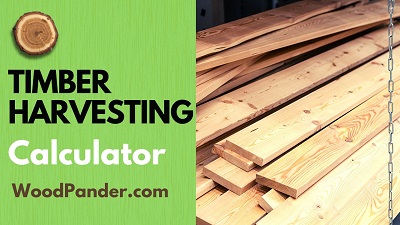Are you involved in the timber industry, either as a logger, forester, or woodworker? Then you know how important it is to accurately measure and calculate the volume of timber logs.
Whether you’re estimating the value of a stand of trees, calculating the amount of wood you need for a project, or determining the weight of a log for transportation, having precise measurements is essential. Fortunately, with the help of technology, calculating timber log volume has become much easier.
In this article, we’ll cover everything you need to know about timber log volume calculators, from how they work to the best ones on the market.
One of our articles –Lumber Pricing Calculator.
What is a Timber Log Volume Calculator?
A timber log volume calculator is a tool that helps you determine the volume of a log of wood. This volume can be measured in a variety of units, including cubic feet, cubic meters, or board feet.
Timber log volume calculators can come in many forms, from simple handheld devices to complex software programs.
They are used by people in the timber industry to determine the value of a stand of trees, estimate the amount of wood they need for a project, or calculate the weight of a log for transportation.
How Does a Timber Log Volume Calculator Work?
A timber log volume calculator works by taking measurements of the log and using a mathematical formula to determine its volume.
The formula used can vary depending on the type of timber log volume calculator you are using. For example, a digital caliper may use a different formula than a Biltmore Stick or Doyle Scale. Generally, the measurements taken will include the length, diameter, and sometimes the taper of the log.
Benefits of Using a Timber Log Volume Calculator
There are many benefits to using a timber log volume calculator, including:
- More accurate measurements: Timber log volume calculators use precise measurements and formulas to provide accurate volume calculations.
- Time-saving: Calculating log volume by hand can be time-consuming and prone to error. Using a calculator can save time and increase efficiency.
- Better decision-making: With accurate volume calculations, you can make better decisions about how to manage your timber resources and estimate the value of your timber.
- Standardization: Using a timber log volume calculator ensures that you are using standardized methods to measure log volume, which can help with consistency and accuracy.
Factors That Affect Timber Log Volume
Several factors can affect the volume of a timber log, including:
- Species of tree
- Diameter and length of the log
- Shape of the log
- Taper of the log
- Bark thickness
- Moisture content
Types of Timber Log Volume Calculators
here are the types of timber log volume calculators available:
- Digital Calipers: These are handheld devices that measure the diameter of a log and use a mathematical formula to calculate the volume. They are easy to use and offer high accuracy, but they are limited to measuring only the diameter of the log.
- Biltmore Stick: This is a wooden stick with scales printed on it that allow you to measure the diameter and length of a log. By using the scales and a mathematical formula, you can calculate the volume of the log. Biltmore sticks are lightweight and portable, but they require some practice to use correctly.
- Doyle Scale: The Doyle Scale is a chart that allows you to estimate the volume of a log based on its diameter and length. It is easy to use and does not require any special tools, but it may not be as accurate as other methods.
- Huber Formula: The Huber Formula is a mathematical formula that allows you to calculate the volume of a log based on its diameter, length, and taper. It is a more complex method than some of the others, but it can provide very accurate results.
- Lumber Rule: A lumber rule is a set of rules used to measure the diameter and length of logs, which can then be used to calculate the volume. Lumber rules are often used in sawmills and can be very accurate, but they can be difficult to use without proper training.
Features to Look for in a Timber Log Volume Calculator

If you are in the market for a timber log volume calculator, here are some features to consider:
- Accuracy: Look for a calculator that provides accurate measurements. The more precise the measurements, the more accurate the volume calculation.
- Ease of Use: Consider a calculator that is easy to use, with clear instructions and a simple interface. The more user-friendly the calculator is, the less room for error there is.
- Range of Measurements: Make sure the calculator can handle a wide range of log sizes, both in terms of length and diameter. This will ensure that you can accurately calculate the volume of all your logs.
- Durability: A timber log volume calculator should be built to last. Look for a calculator that is made of sturdy materials and has a protective case to prevent damage during use.
- Compatibility: If you plan to use the calculator with other tools, such as software or equipment, make sure it is compatible. This will ensure that you can easily transfer data and avoid any compatibility issues.
- Display: Look for a calculator with a clear and easy-to-read display. This will make it easier to read the measurements and avoid mistakes.
- Battery Life: Consider a calculator with a long battery life, especially if you plan to use it for extended periods of time without access to a power source.
- Price: Compare prices of different calculators to find one that fits your budget while still meeting your needs.
By considering these features, you can find a timber log volume calculator that will meet your needs and help you accurately calculate the volume of your logs.
Top Timber Log Volume Calculators on the Market
Here are some of the top timber log volume calculators on the market today:
- Log-Boy: This is a digital log volume calculator that allows you to measure the diameter and length of logs and calculate their volume. It is easy to use and provides accurate measurements. The Log-Boy also comes with a protective case and a user manual.
- Timbeter: Timbeter is a software solution for log measurement that uses artificial intelligence and machine learning to measure logs using photos taken with a smartphone. It is a user-friendly solution that eliminates the need for physical measurements and provides fast and accurate results.
- LaserTech TruPulse 360R: This is a handheld laser rangefinder that can measure distances, heights, and angles. It can be used to measure the height and diameter of trees, as well as the length and diameter of logs. The TruPulse 360R is durable and easy to use, with a clear display and intuitive interface.
- Haglof DP II: The Haglof DP II is a digital caliper that can measure the diameter of logs up to 50 cm and calculate their volume. It has a large, easy-to-read display and comes with a protective case. The DP II is accurate and easy to use, making it a great choice for anyone in the timber industry.
- Biltmore Stick: The Biltmore Stick is a classic tool for measuring logs. It is a wooden stick with scales printed on it that allows you to measure the diameter and length of logs and calculate their volume. It is lightweight and portable, making it a great option for those who work in the field.
By considering these options, you can find a timber log volume calculator that meets your needs and helps you accurately measure the volume of your logs.
How to Use a Timber Log Volume Calculator
Using a timber log volume calculator is a straightforward process. Here are the steps to follow:
- Measure the Diameter: The first step is to measure the diameter of the log at its smallest point. If the log is not perfectly round, measure the diameter in two or three places and average them to get an accurate measurement.
- Measure the Length: Measure the length of the log from one end to the other. Be sure to measure from the same points on each end to ensure accuracy.
- Enter the Measurements: Enter the diameter and length measurements into the timber log volume calculator. Some calculators will have separate fields for diameter and length, while others may only require one measurement for both.
- Calculate the Volume: Once you have entered the measurements, the calculator will provide you with the volume of the log. This is usually expressed in cubic feet or cubic meters.
- Repeat for Additional Logs: If you have multiple logs to measure, repeat the process for each log and add up the volumes to get the total volume of your timber.
Tips for Accurately Measuring Timber Log Volume
Accurately measuring timber log volume is essential for determining the value of your timber and managing your forest resources effectively. Here are some tips for ensuring accurate measurements:
- Use Appropriate Tools: Choose the right tools for the job. A digital caliper or tape measure is typically used to measure the diameter of logs, while a measuring tape is used to measure the length. There are also specialized tools, such as laser rangefinders and smartphone apps, that can be used to measure logs.
- Measure at the Right Point: The diameter of a log should be measured at its smallest point, usually near the middle. Measuring the diameter at the widest point can result in an overestimate of the log’s volume.
- Measure Length Carefully: To get an accurate measurement of the log’s length, be sure to measure from the same points on each end. Also, be sure to account for any curves or bends in the log that could affect the measurement.
- Be Consistent: To ensure accurate measurements, be consistent in your methods. Use the same tools and techniques for every log, and measure them at the same point in the harvesting process.
- Consider Factors That Affect Volume: The volume of a log is affected by its taper, which means it is wider at one end than the other. Be sure to measure the diameter at the small end of the log, and use a taper chart or formula to adjust the volume calculation accordingly.
- Use a Timber Log Volume Calculator: A timber log volume calculator can help you ensure accuracy in your measurements. These calculators take into account the shape of the log and its taper to provide accurate volume calculations.
See Also: Log Volume Calculator Tool.
Related Questions- Timber Log Volume Calculator
How do you find the volume of a timber log?
To find the volume of a timber log, measure the length, diameter at the small end, and diameter at the large end, and then use a formula such as the Doyle Scale or International Scale to calculate the volume in board feet or cubic meters.
How do you calculate wood logs?
Wood logs can be calculated by measuring the length, diameter, and taper of the log, and then using a log scaling formula to estimate the board feet or cubic meters of wood.
How do you calculate wood volume?
Wood volume can be calculated using various formulas, depending on the shape and dimensions of the wood. For example, for a rectangular piece of wood, volume = length x width x height.
How do you calculate log m3?
To calculate log m3, measure the length and diameter of the log, and then use a formula such as the International Scale or Smalian’s Formula to calculate the volume in cubic meters.
What is the formula for calculating log?
The formula for calculating log volume varies depending on the scaling system being used, but typically involves measuring the length and diameter of the log and using a mathematical formula to calculate board feet or cubic meters.
What is the calculation of log?
The calculation of log volume depends on the scaling system being used, and involves measuring the length and diameter of the log and using a formula to estimate the board feet or cubic meters.
What is log volume measurement?
Log volume measurement is the process of measuring the dimensions of a log and using a scaling formula to estimate the board feet or cubic meters of wood it contains.
How do you calculate timber CFT?
To calculate timber CFT (cubic feet), measure the length, width, and thickness of the wood and then multiply the three dimensions together.
What is the volume of 1 ton of wood?
The volume of 1 ton of wood depends on the species and moisture content of the wood, as well as the density and specific gravity of the wood. Generally, 1 ton of wood will occupy between 1.5 and 2.5 cubic meters.
How is timber value calculated?
Timber value is calculated based on various factors, including wood species, size, grade, market demand, and current market conditions. Pricing may be based on per board foot, cubic meter, or other units of measure, depending on local customs and practices.
See Also: Lumber Pricing Calculator.
Conclusion
a timber log volume calculator is a useful tool for accurately measuring the volume of logs. By measuring the diameter and length of a log and entering the measurements into a calculator, you can quickly and easily calculate the log’s volume. There are various types of timber log volume calculators available on the market, each with different features and capabilities. When choosing a calculator, it is important to consider factors such as accuracy, ease of use, and compatibility with different types of logs.
To ensure accurate measurements, it is important to use appropriate tools, measure at the right points, and be consistent in your methods. You should also consider factors that affect volume, such as taper, and use a taper chart or formula to adjust the volume calculation accordingly.
Overall, a timber log volume calculator is an essential tool for anyone involved in the timber industry. By using a calculator to accurately measure log volume, you can make better decisions about managing your forest resources and maximizing the value of your timber.








